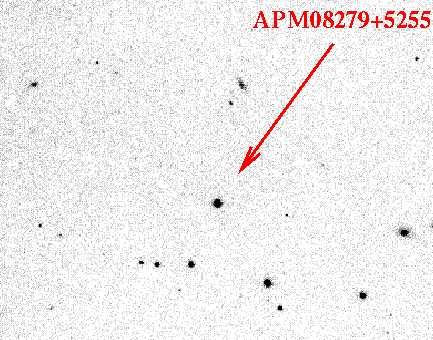
|
Credit: M.J. Irwin (RGO),
R.A. Ibata (ESO),
G.F. Lewis (U. Washington, U. Victoria), and
E.J. Totten (Keele U.),
Isaac Newton 2.5-m Telescope
Explanation:
It shines with the brightness of 100 billion Suns.
Is it a mirage? The recently discovered
quasar labeled
APM 08279+5255 has set a new record
as being the brightest continuously emitting object yet known.
APM 08279+5255's great distance, though, makes it
only appear as bright as magnitude 15.2,
an object which can be seen with a moderate sized telescope.
It is the quasar's extreme
redshift of 3.87 that places it far across our universe,
and implies a truly impressive energy output.
One possible explanation of APM 08279+5255's
record luminosity is that it is partly a mirage:
its light is highly magnified by an intervening
galaxy that acts as a
gravitational lens. Alternatively,
APM 08279+5255 might be the most active known center
of an intriguing class of
colliding galaxies rich in gas and
dust.
|
January February March April May June July August September October November December |
| |||||||||||||||||||||||||||||||||||||||||||||||||||||||
NASA Web Site Statements, Warnings, and Disclaimers
NASA Official: Jay Norris. Specific rights apply.
A service of: LHEA at NASA / GSFC
& Michigan Tech. U.
Based on Astronomy Picture
Of the Day
Publications with keywords: quasar
Publications with words: quasar
See also:
